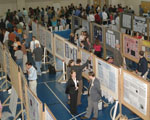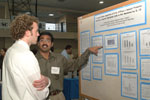Student Research Day 2005
by Dick
PetersonSpecial to The Catalyst
If Olympic team events included chemistry and mass spectrometry, Don Catlin, M.D., could display 25 years of gold medals for his victories over molecules meant to make athletes faster, higher and stronger than their opponents.
 Participants and
visitors gather in the Harper Student Wellness Center gymnasium during
the annual Student Research Day 2005 Nov. 4.
Participants and
visitors gather in the Harper Student Wellness Center gymnasium during
the annual Student Research Day 2005 Nov. 4.At the conclusion of Student Research Day on Friday (Nov. 4), Catlin described victory after victory in a Herculean contest that he will probably never win. As director of the only anti-doping lab in the U.S., Catlin and his UCLA-based team probe the molecular structure of substances gleaned from routine urine specimens to residue in a used syringe shipped anonymously to his lab.
“Citius, Altius, Fortius. I have to tell you about swifter, higher, stronger, the Olympic motto,” he said, referring to his first slide. “I’ve superimposed it on a molecule which you will immediately recognize as being THG, tetrahydrogestrinone.”
Doubtful that few if any in his audience would immediately recognize the molecule, Catlin described THG, the latest in a long line of designer steroids. It’s the latest Catlin’s lab identified, leading to indictments against a California lab, Balco, for distributing performance-enhancing drugs to athletes. The discovery also led to the elimination of a string of U.S. athletes from competition prior to the 2004 Olympics.
Catlin’s recap of the use of performance-enhancing drugs reached back into the 1960s when British cyclist Tommy Simpson collapsed and died of arrhythmia during the Tour de France, his body loaded with amphetamines. Waves of performance-enhancing drugs have since played a role, some more than others, in achieving that swifter, higher, stronger edge that just might make a great athlete the greatest.
“It’s a very sad story, but I don’t want you to come away with the idea that sport is completely corrupt.” Catlin said that it is easy to feel that the higher an athlete goes in his sport, the closer he gets to the top, the more likely it is he is using drugs.
“We aren’t losing all the battles. We are winning some of them,” Catlin said. “No bikers are ever taking amphetamines again. Why? Because they are too easy to test for and your body would be so overwhelmed that the mass spectrometer would probably get overloaded.”
He said that while the particular problem that killed Simpson is finished, it has been replaced by others.
In archery and other shooting competitions, beta blockers that will slow the heart to below 60 beats per minute can enhance performance. A longer interval between heartbeats gives the shooter the steady time he needs to avoid translational motion from his heartbeat to his hand. Catlin’s lab tests for 60 beta blockers, but 120 have been prescribed.
But not all shooters beta block. A biathlete who combines timed skiing with shooting skills can’t afford to. He’d never win if he couldn’t get his heart rate above 180 after he shoots, Catlin said. “There’s a self-imposed lack of need for beta blockers in this particular sport. It’s one reason I kind of like the beatings these folks can take.”
Although anabolic steroids have been around since the 1960s in weightlifting, no one paid much attention to them until they appeared in track and field competitions. Ben Johnson held the track and field record for one day in the 1988 Olympics in South Korea. Once it was confirmed that his bulging muscles were the result of anabolic steroid use, the medal went to Carl Lewis and Johnson’s record was expunged.
More than 170,000 samples were tested in 2004, a small number compared to the number of sports and athletes competing. “If you are really going to control for drugs, you’re going to have to test three times a day.”
Another drug to enhance performance, testosterone, is already present in everyone’s body, men and women, a fact that makes the drug particularly difficult to detect. One way it can be detected at an abnormal level, Catlin said, is to measure its ratio to epi-testosterone. “If the ratio is more than 6-to- 1, big problem,” he said. A way around the ratio problem has been marketed by Balco as “The Cream.” It’s a mixture of testosterone and epi-testosterone in the right proportion to mask the higher than normal level of testosterone.
“They had about a five-year run when their drugs were being used and we weren’t catching them,” Catlin said. He noted lots of activity in testosterone doping, “but we’ve made some progress,” he said.
Catlin said that he learned the fastest way to get a performance-enhancing drug off the market is to publish its discovery, not in scientific journals, but in the Washington Post. As a scientist he finds it frustrating that his work would have to bypass the review of his peers. “We may lose four or five publications, but we have the satisfaction that the Washington Post gets around.” Congress doesn’t like it when the laws they pass don’t work, so publication in the press keeps the FDA jumping.
The nature of chemistry and steroids can keep the doping and anti-doping game going for a long time, Catlin said. By adding tweaks here and there, steroids can keep changing, forcing anti-doping labs to continually discover each change before it can be banned.
Next on the horizon? Human growth hormone, Catlin said. “We fear they take it, but we don’t know how much. We can’t detect it, but we hope someday we’ll have a test.” To the question: “Are we winning or losing?” Catlin said the last year was phenomenal. The federal government was out there with its tools: taping, wiretapping, seizing hard drives, and holding Congressional hearings. “And I have no idea why. It’s a new era now and I’m looking to next year when it will all die down, and all these new designer drugs show up.”
Catlin said that there are plenty of good, clean athletes who compete against people who are dirty. But as soon as they win, they are accused of being on drugs, even if they are found to be clean. “There has to be another way. We have to have another plan. I’m trying to get funding to take a different approach, to take them as individual people. A phase 2 program that will reward them as good people who win.”
 Arindam Saha
presents his group's research poster to a visitor during the Student
Research Day 2005, Nov. 4. Their presentation, entitled “H. Pylori
Down-Regulation of H,K-Atpase A Subunit Promoter in Gastric Epithelial
Cells is Not Mediated by IL-1b” was shared by Saha, Charles E. Hammond,
and Adam J. Smolka, Department of Medicine, Division of
Gastroenterology and Hepatology.
Arindam Saha
presents his group's research poster to a visitor during the Student
Research Day 2005, Nov. 4. Their presentation, entitled “H. Pylori
Down-Regulation of H,K-Atpase A Subunit Promoter in Gastric Epithelial
Cells is Not Mediated by IL-1b” was shared by Saha, Charles E. Hammond,
and Adam J. Smolka, Department of Medicine, Division of
Gastroenterology and Hepatology.Student Research Day Winners
Session 1: 1st place—Lorraine Beraho; 2nd place—Komal Rastogi
Session 2: 1st place—Robin Min-hinnett; 2nd place—Laura Mills
Session 3: 1st place—Fozail Alvi; 2nd place—Erica Kemppa
Session 4: 1st place—Jennifer Konopa; 2nd place—Blake Ellis
Session 5: 1st place—Julie Woolworth; 2nd place—Kevin Francis
Session 6: 1st place—Ryan Monfeli; 2nd place—Kathleen Willett
Session 7: 1st place—Peko Tsuji; 2nd place—Jennifer Schepp
Session 8: 1st place—Megan Kibbey; 2nd place—Laura Spruill. The first place in this session is also the 2005 Kinerd-Gadsden Graduate Alumni Award winner
Session 9: 1st place—Vijayalakshmi Sridharan; 2nd place—Kannan Kunchithapautham
Session 10: 1st place—Christopher Robinson; 2nd place—Sarah Imam
Session 11: 1st place—Boyd Lever; 2nd place—Roopa Varadarajan
Session 12: 1st place—John T. Lucas; 2nd place—Michael Aho
Session 13: 1st place—Dan-Victor Giurgiutiu; 2nd place—Lembe Ambe
Session 14: 1st place—Amy Bardeen; 2nd place—Saeed Elojeimy
Session 15: 1st place—Kristen Johnson; 2nd place—Lindsey Jutzeler
Session 16: 1st place—Adrian Grimes; 2nd place—Gregor Krings
Session 17: 1st place—Hongkuan Fan; 2nd place—Mark Feldmann
 Student Research
Day 2005 winners.
Student Research
Day 2005 winners.Library-Bioinformatics: 1st place—Bin Zheng; 2nd place—Scott W. Miller
Sigma Xi Award: Peko Tsuji
Visit http://www2.musc.edu/Graduate/SRD/2005/Program.html
Friday, Nov. 11, 2005
Catalyst Online is published weekly,
updated
as needed and improved from time to time by the MUSC Office of Public
Relations
for the faculty, employees and students of the Medical University of
South
Carolina. Catalyst Online editor, Kim Draughn, can be reached at
792-4107
or by email, catalyst@musc.edu. Editorial copy can be submitted to
Catalyst
Online and to The Catalyst in print by fax, 792-6723, or by email to
petersnd@musc.edu
or catalyst@musc.edu. To place an ad in The Catalyst hardcopy, call
Community
Press at 849-1778.